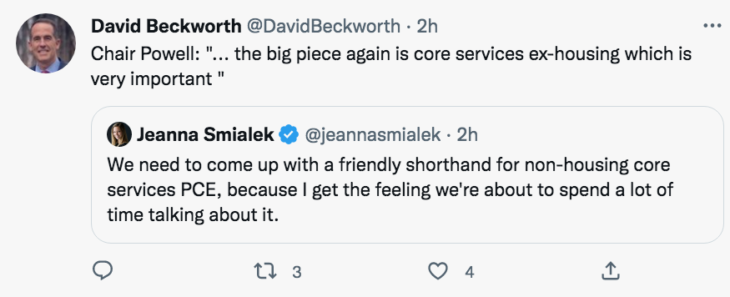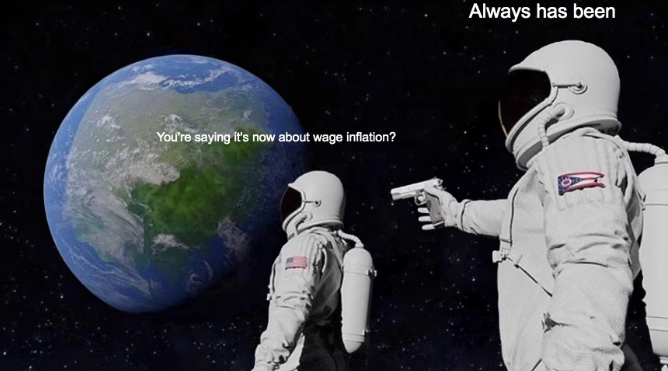David Beckworth directed me to a tweet by Jeanna Smialek:

A friendly shorthand for non-housing core services PCE? How about “wages”?
When nominal wages grow at about 3 percent per year, inflation will average 2 percent in the long run. In that case, any deviations in the headline inflation rate will be transitory. The burst in inflation that began in 2021 went from being transitory to permanent when it became embedded in wage inflation.
If you listen closely to Jay Powell, it’s pretty clear that he understands that fact. But the Fed is reluctant to say this out loud. It sounds bad to emphasize that the number one goal of the Fed right now is to reduce wage increases. When the public hears that, they think in terms of real wages. Actually, a tight money policy that slows the growth of nominal wages will tend to cause real wages to rise in the short run. Some of the largest increases in real hourly wages occurred in years like 1921 and 1930, when nominal wage growth slowed due to tight money, but consumer prices fell much more dramatically.
Goods inflation is already slowing. Housing prices (part of services) are still rising due to the lagged effects of rent contracts signed earlier in 2022. But the inflation rate of “spot” rents on new rental contracts has begun slowing, and overall average level of rents will eventually follow suit. Today, the main outstanding problem is fast rising nominal wages, which is the primary factor behind non-housing service prices. But then nominal wage inflation has always been the essential monetary policy problem, as price inflation is a misleading guide to policy that mixes supply and demand side influences.
In other words:


READER COMMENTS
Garrett
Dec 15 2022 at 8:42am
Is this the best indicator of nominal wages? Is there one that goes farther back than 2006?
Scott Sumner
Dec 16 2022 at 11:42am
To go back earlier you need to look at manufacturing wages.
Spencer
Dec 15 2022 at 11:58am
Which is contracting faster, inflation or R-gDp? Economists flunked accounting. Powell blew it. Armageddon is now upon us.
Spencer
Dec 15 2022 at 12:25pm
The O/N RRP still has 2 trillion invested, cash for “certificates of confiscation”.
Rafael Velasquez
Dec 15 2022 at 4:24pm
Professor Sumner,
Couldn’t the current widening divergence between inflation measures and wage growth simply represent a return to trend for wages relative to profit?
In other words next year we will see employment costs rise faster for corporates than revenue bringing their (historically high) profit margins back to where they were pre-pandemic.
The excess wage growth is a change in ‘relative prices’ to misuse the term rather than a change in the price level.
It seems a simple causal link might be:
Government Stimulus –> Increased demand –> Corporates raise prices (i.e. inflation) –> profits increase as wages are sticky –> real wages drop –> as time goes on workers negotiate real wages back up –> wage growth exceeds price growth –> profits decrease.
The inflation all happened at the beginning; the rest was simply the economic adjustment to it without necessating an inflationary spiral.
The IMF has a recent paper that seems to argue for this:
https://www.imf.org/en/Publications/WP/Issues/2022/11/11/Wage-Price-Spirals-What-is-the-Historical-Evidence-525073
Scott Sumner
Dec 16 2022 at 11:47am
Rafael, I’d rather bring about the new equilibrium with lower price inflation, rather than higher wage inflation.
Rafael Velasquez
Dec 18 2022 at 5:12pm
Thank you very much for the reply Professor.
My point was more that current high wage growth doesn’t necessarily imply higher future inflation as we’ve seen coincident inflation measures already start dropping with leading ones heading even lower.
The remaining inflationary concern in my opinion is wage growth, but its perhaps an unnecessary concern and may lead the Fed to commit a 08 style policy mistake where they refuse to ease in the face of a rapidly weakening economy.
Comments are closed.